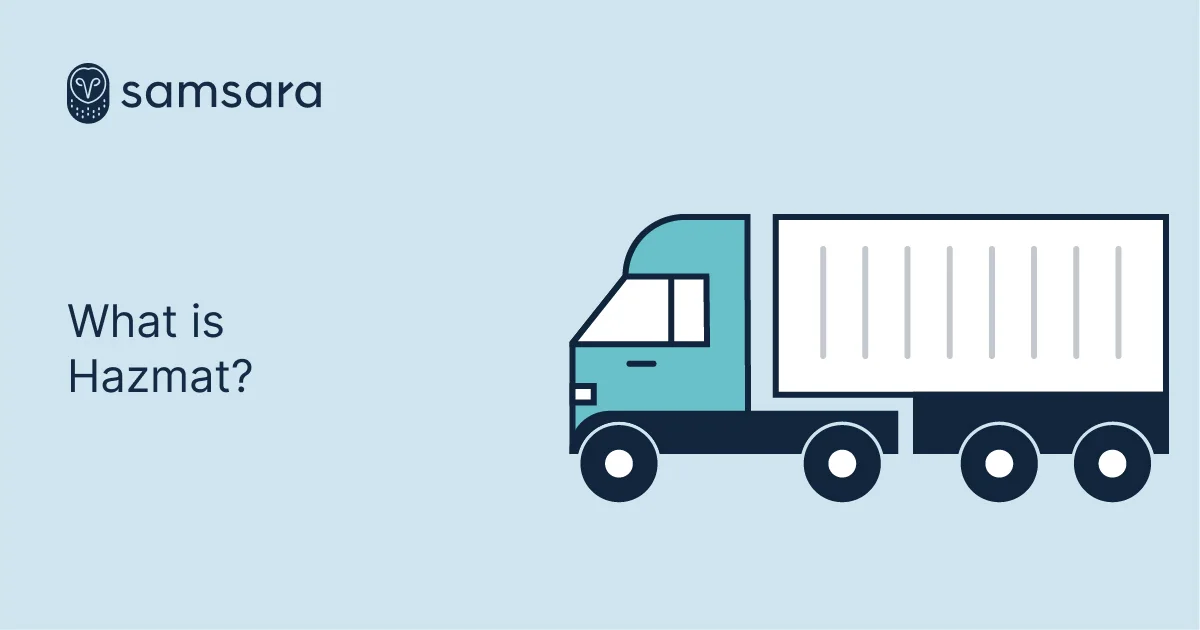What is Hazmat?
October 22, 2021

Get Started with Samsara
Check our pricesKey Takeaways
Transporting hazardous materials, also called hazmat, can pose serious safety risks. To protect everyone from hazmat risks, there are strict regulations on how it can be transported and who can transport it. Learn more about what hazardous materials are, basic fleet regulations, and what hazmat endorsements are.
What is hazmat?
Hazmat is an abbreviation for hazardous materials, as classified by the U.S. Environmental Protection Agency (EPA). People in the fleet and logistics industry associate the term “hazmat” with tanker driving because many common hazardous materials and dangerous goods, such as oil, gasoline, and chemicals, are transported in bulk via tanker trucks.
Transporting hazmat poses significant safety risks, so it must be properly classified, packaged, labeled, handled, and stowed for transportation. This protects workers, drivers, and the general public from hazmat risks.
What are considered hazardous materials?
The transport of hazardous materials is strictly regulated by the U.S. Department of Transportation (DOT). It defines hazmat as articles or substances which are capable of posing risks to health, safety, property, or the environment. These may include items such as explosives, gases, flammable liquids and solids, and more.
Some common hazardous materials include:
Aerosol spray receptacles
Dry ice
Lithium batteries, including portable chargers and power banks
Alcohols (rubbing alcohol, high-proof spirits)
Fertilizer compounds and ammonium nitrate fertilizers
Oxygen tanks (medical and recreational)
Ammunition and gun powders
Fireworks–consumer and novelty
Paints, paint thinners and removers
Bleaches
Fragrances (perfumes and colognes)
Refrigerant gases (e.g., liquid nitrogen or carbon dioxide)
Camping equipment ( camping stove, kerosene lanterns)
Fuels (gasoline, diesel, propane, kerosene)
Scuba tanks
Car batteries
Fuel-powered equipment (containing fuel)
Swimming pool chemicals
Consumer electronics with lithium batteries (cell phones, laptops)
Insecticides and pest control products
Wood treatment products (sealants, stains, varnishes)
When do hazardous materials regulations apply?
Fleets transporting hazardous materials intrastate, interstate, and across borders are subject to the Pipeline and Hazardous Materials Safety Administration (PHMSA) regulations. Any worker considered a “hazmat employee” must receive training on regulations every three years or whenever job functions change.
While drivers transporting hazardous materials qualify as “hazmat employees,” other workers who come into close contact with materials also qualify. They include anyone who loads, unloads, or handles the hazmat. Hazmat employees also encompass people who manufacture packages or containers used for transporting hazmat, prepare hazmat for transportation, or are responsible for the safe transportation of materials.
What is a hazmat endorsement?
A hazmat endorsement is an additional certification added to a commercial driver’s license (CDL) that allows drivers to transport hazardous materials. Like the CDL itself, the hazmat endorsement is administered by a state Department of Motor Vehicles (DMV).
Because hauling hazardous material requires more attention, drivers must prove to officials and trucking companies that they have passed training requirements and know what they’re hauling. Typically salaries are higher for those who obtain the certification due to the hazmat training and shortage of drivers.
There are three different types of hazmat endorsements:
H endorsement: Applies to all hazmat drivers. The H endorsement is required for transporting hazardous materials. In addition to the written knowledge test, drivers must submit a Transportation Security Administration (TSA) Security Threat Assessment application with fingerprinting.
N endorsement: The N endorsement allows drivers to operate a tank vehicle, which is used specifically for transporting liquids or liquefied gases. The trucking industry primarily uses tankers to transport hazardous materials.
X endorsement: This endorsement combines the H and N endorsements. This is a popular choice for hazmat drivers. They gain the certification to transport hazmat and operate a tanker on a single certificate.